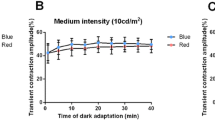Abstract
The micropig is viewed by many as one of the best animal models of human system physiology. The purpose of this study was to develop a simple, rapid and reliable method to record clinical electroretinograms from conscious adult Yucatan micropigs. Photopic ERGs were recorded from 18 conscious animals following a 3-h period of preadaptation to a moderate photopic environment. Rectal temperature and blood pressure were monitored throughout the experiment. In order to test the reproducibility of our procedure, the same protocol was repeated (n=6 micropigs) on three different recording sessions each separated by a 48-h period. Our results indicate that the recording of reproducible ERGs, in the conscious Yucatan micropig, is feasible provided that an adequate experimental approach is used. We believe that our method will enable investigators to perform retinal physiology experiments using an approach which is compatible with that used in a human clinical setup thus facilitating the transposition of experimental data from animal to human.
Similar content being viewed by others
References
Hao Y, Soref CM, Gerke CG. The visual pigment gene family and the distribution of photoreceptors in the pig retina. Invest Ophthalmol Vis Sci 1992; 33: 1004.
Simoens P, de Schaepdrijver L, Lauwers H. Morphologic and clinical study of the retinal circulation in the miniature Pig. A:morphology of retinal microvasculature. Exp Eye Res 1992; 54: 965–73.
Saint-Macary G, Berthoux C. Ophthalmologic observations in the young yucatan micropig. Lab Anim Sci 1994; 44: 334–7.
Sato S. Toxic effects on the visual system of diaminophenoxybutone, quinine and ethambutol in conscious dog. Appl Toxicol 1985; 5: 777–84.
Bodis-Wollner I, Marx MS, Ghilardi MF. Systemic haloperidol administration increases the amplitude of the light-and dark-adapted flash ERG in the monkey. Clin Vis Sci 1989; 4: 19–26.
Sato S, Sugimoto S, Chiba S. A procedure for recording electroretinogram and visual evoked potential in conscious dogs. J Pharmacol Methods 1982; 8: 173–81
Millar TJ, Vaegan, Arora A. Urethane as a sole general anesthetic in cats used for electroretinogram. Neurosci Lett 1989; 103: 108–12.
Vaegan, Arora A, Crewther, SG, Millar, T J. The effect of various anesthetics on the spatial tuning of two major wave peaks in the transient pattern electroretinogram of the cat: evidence for pattern and luminance components. Vis Res 1990; 30: 1401–7.
Rojas L M, McNeil R, Cabana T, Lachapelle P. Diurnal and nocturnal visual function in two tactile foraging waterbirds: the american white ibis and the black skimmer. Condor 1997; 99: 191–200.
Hanna N, Lachapelle P, Roy M S, Orquin J, Varma D R, Chemtob S. Alterations in the electroretinogram of piglets by propionic acid-derivative nonsteroidal antiinflammatory drugs but not indomethacin and diclofenac. Pediat Res 1995; 37: 81–5.
Narfström K, Andersson B-E, Andreasson S, Gouras P. Clinical electroretinography in the dog with Ganzfeld stimulation: a practical method of examining rod and cone function. Doc Ophthalmol 1995; 90: 279–90.
Schaeppi U, Liverani F. Procedures for routine clinical electroretinography (ERG) in dogs. Agents Actions 1977; 7: 347–51.
Buist D P, Heywood R. A standardized procedure for electroretinographic examination of rhesus monkeys (Macaca mulatta). Lab Anim Sci 1982; 32: 91–3.
Goto Y. An electrode to record the mouse cornea electroretinogram. Doc Ophthalmol 1996; 91: 147–54.
Rosolen SG, Lazard P, Rigaudiè re F. Exploration indirecte du fonctionnement de l'épithélium pigmenté par électrorétinographie chez le macaque rhésus (Macaca mulatta) Ophtalmol 1997; 11: 359–64.
Rosolen SG, Malecki H, Le Gargasson JF. Effects of acepromazin and droperidol on dark-adapted ERG in rhesus monkeys. Invest Ophthalmol Vis Sci 1996; 37: S344.
Rosolen SG, Rigaudiè re F, Lazard P, Saint-Macary G, Le Gargasson JF. Comparison between humans and non sedated adult micropigs ERGs during dark-adaptation. Invest Ophthalmol Vis Sci 1997; 38: S887.
Rights and permissions
About this article
Cite this article
Rosolen, SG., Rigaudiere, F., Saint-Macary, G. et al. Recording the photopic electroretinogram from conscious adult Yucatan micropigs. Doc Ophthalmol 98, 197–205 (1999). https://doi.org/10.1023/A:1002445219981
Issue Date:
DOI: https://doi.org/10.1023/A:1002445219981




